
Intel Corp. (NASDAQ: INTC) recently released its new 10th generation desktop processors, including the new Core i9-10900K. With speeds up to 5.3GHz, the chip is “the world’s fastest gaming processor,” Intel says.
Intel has faced stiff competition from Advanced Micro Devices Inc. (NASDAQ: AMD), thanks to its third-generation Ryzen chips. Many buyers will be comparing the Ryzen 9 3900X, a 12-core chip, with the new Intel offering, a 10-core chip. The i9-10900K is selling for $488, while the Ryzen 9 3900X is selling at a discounted $410-$420.
AMD was the best-performing stock in the S&P 500 last year, gaining 148%. On Friday, the stock was near its 52-week high. The stock price closed at $55.17 (up 0.95%), while the S&P 500 was up 0.24%.
AMD shares are up 20.3% year to date, while Intel is up 4.02% and NVIDIA Corp. (NASDAQ: NVDA) is up 53.44%.
When AMD reported first-quarter results in late April, the chipmaker came in slightly below profit estimates and slightly above estimates for revenue. For the quarter, AMD said that it had $0.14 in earnings per share (EPS) and $1.79 billion in revenue. Analysts were expecting $0.18 in EPS and $1.78 billion in revenue.
Chip Battle
The tech press has favorably reviewed the i9-10900K, to a point. The flagship chip “excels in elite gaming scenarios, but its aging architecture can’t quite keep pace with AMD’s newer, nimbler 7 (nanometer) designs on value and multi-threaded performance,” PC Magazine said this week.
PC World confirmed Intel’s claim of having the fastest gaming processor. “Intel’s problem has been weaknesses outside of gaming, and its overall performance value compared to AMD’s Ryzen 3000 chips,” the magazine said. “With the Core i9-10900K, Intel doesn’t appear to be eliminating that gap, but it could get close enough that you might not care.”
One point of criticism is that Intel’s new chip is built on the company’s aging 14-nanometer technology, around since 2015. AMD’s Ryzen line launched in 2017. AMD’s product roadmap for late 2020 includes the launch of its next generation of processors, dubbed Zen 3.
In the meantime, AMD is stealing market share from Intel. Both Microsoft Corp. (NASDAQ: MSFT) and Lenovo launched new laptops this year using Ryzen chips. Looking ahead to the holidays, eagerly awaited Xbox and Playstation models are expected to use AMD chips.
Where Chips Go, So Goes the Market?
Wall Street is watching the chip battle closely. Many consider semiconductors to be a leading indicator for the market as a whole. The reason is that as technology continues to improve, more industries see improvements and business gets better overall. Semiconductors have applications across practically all industries, and a rising tide lifts all ships.
Looking forward, AMD did not withdraw financial guidance as a result of COVID-19 uncertainty. Instead, the company said it expects revenue of around $1.85 billion (plus or minus $100 million), a year-over-year increase of 21% and a sequential increase of 4%. The company expects 2020 revenue to rise in a range of 20% to 30% year over year and to realize adjusted gross margin of approximately 45% for the year.
The coronavirus remains the long-term unknown, according to Trefis, a forecasting firm. It said this week that the pandemic “has led to slowdown in industrial and economic activity, thus affecting consumer spending power. Lower consumption will lead to lower demand for laptops, computers, and gaming consoles, leading to lower demand for graphics processors. This would lead to a drop in demand for AMD’s products.”
A disruption to the manufacturing chain is another risk. If the world sees big new waves of the virus in the fall, it could cause factories to close again. Or supply chains could seize up.
In Trefis’s worst-case scenario, AMD stock could slide to $30 per share. Stock market analysts have assigned AMD an average 12-month price target of $51.97. Nineteen analysts still rate AMD a Buy, and 14 say Hold.
U.S.-China trade relations also lurk in the background for chip makers and technology companies that do business in China. As President Trump has stepped up criticism of Beijing for its handling of COVID-19, fears of a new trade war and new tariffs have risen.
With the U.S. presidential election approaching, some analysts fear China could become a new punching bag for American politicians. American companies could be collateral damage.
Thank you for reading! Have some feedback for us?
Contact the 24/7 Wall St. editorial team.





